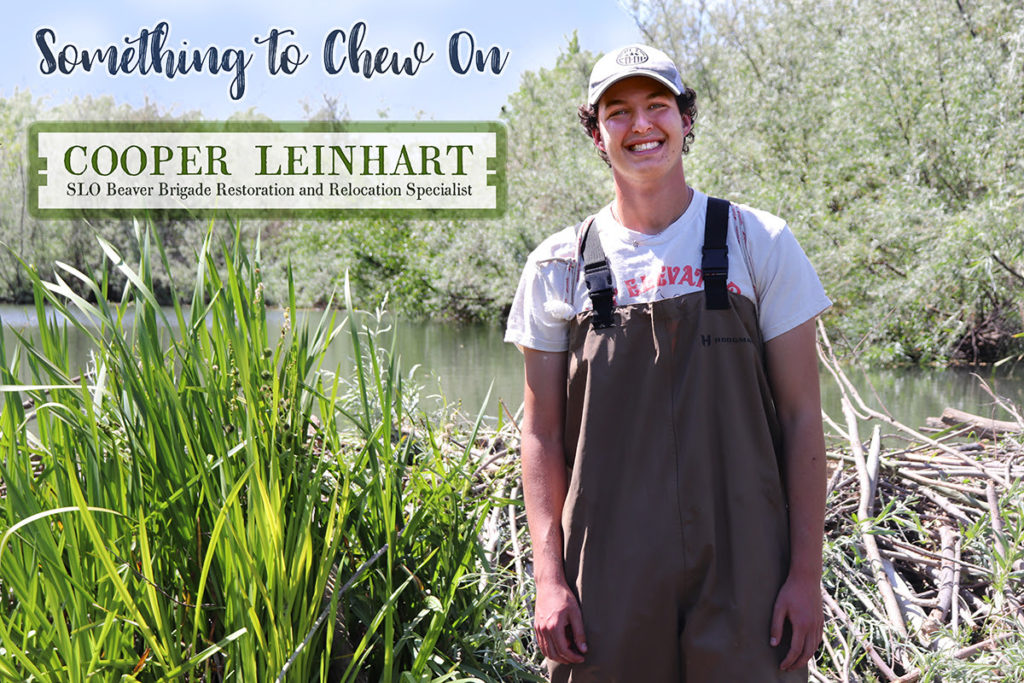by Cooper Lienhart

Cooper Lienhart certainly thinks so! In his words, “The best way I know to help the planet?— is to support the beavers!”
My name is Cooper, and I’m a Beaver Believer — not only because of their cuteness, but actually because of climate change. Ever since high school I have been dedicated to researching and being part of the solution for climate change, and that path has twisted and turned and eventually led me right to beavers!
It all started, surprisingly, in the suburbs of Chicago. I had a big project in my Earth Science class about climate change. I was immediately shocked by my research and just how drastic the situation seemed. I felt that there had to be something we could invent to suck the CO2 back out of the atmosphere and cool us down. That sparked my inner fire, because I felt for the first time like I could take my knowledge and use it in a meaningful and helpful way.
Several years later I got out of the cold and continued my path as an environmental engineer at Cal Poly. During this time I was lucky enough to study abroad in Iceland and Greenland on a program specific to climate change. While there I was absolutely in awe of the natural beauty of the Earth. I played under the northern lights, saw arctic foxes, and made it to the Arctic Circle. The lectures and courses I took reinforced my fears about the dire state of our climate, but I also came away with hope and a heck of a lot of motivation. The most powerful lesson I learned was that our natural ecosystems offer the most effective ways to store carbon. Wetlands in particular are the most efficient terrestrial ecosystems for absorbing and storing CO2 from the atmosphere. After learning this, I worked with an Icelandic professor studying wetland restoration to determine how to best restore wetlands for optimal greenhouse gas storage.

Coming back to California, I was full steam ahead on wetlands, and the next summer I got my feet wet weeding invasive species from the Sweet Springs Marsh at Morro Bay. That’s where I started to fall in love with the lush, peacefulness of wetlands. Luckily, that was just the beginning of my relationship with wetlands. Thanks to the local group Biodiversity First! I was connected with Audrey Taub and the newly formed Beaver Brigade. Once I saw the wetlands that the beavers created, so full of life, I couldn’t believe it. All I had ever learned was that beavers cut down trees, and now I was standing in a literal oasis during the middle of a historic drought. The more I learned about beavers the more I was amazed — they’re able to turn a degraded stream with little life or value into this complex of ponds that benefit us all and are huge carbon sinks that are home to thousands of critters.
There are a couple of factors that make beaver wetlands so successful at carbon storage and climate change mitigation. First, they create slow moving water and abundant vegetation. As plants grow they store carbon in their bodies, and often times in wetlands the plants get trapped either under the water or under the soil. Because of the lack of oxygen, they can’t decompose, and the carbon gets buried and trapped underground. That carbon will eventually be condensed into peat and then coal. A fun fact is that all of our coal reserves were once vast, lush wetlands millions of years ago. Another way beavers encourage CO2 capture is by their chewing habits! A mature tree won’t absorb as much carbon as a rapidly growing young tree. When a beaver chews down a tree, since the tree has evolved with beavers for millions of years, it won’t die, but will sprout new growth. And this growth is bitter tasting to the beavers for seven years. These new sprouts are growing into thick branches and locking the carbon away as new wood. Eventually, the beavers will take that branch, strip the bark to eat, and use the inner wood to build more dams. This creates more wetlands and continues the cycle of more carbon storage!

But wait, there’s more! The wood chips that beavers make while chewing get buried in the soil to further aerate and carbonize the soil. Dr. Emily Fairfax, beaver scientist, says that beaver wetlands hold at least 10-12 times more carbon than grasslands and degraded streams. Dr. Fairfax also researches how beaver wetlands won’t burn during wildfires. That means they can create vital firebreaks that can protect our communities as climate change exacerbates our wildfires. The beaver dams also allow the water to sink back underground, recharging our aquifers, and helping us prepare for droughts.
What can’t the beavers do? They are not only helping us keep the planet cool, but they’re protecting us from some of the damaging effects we’re seeing from climate change.